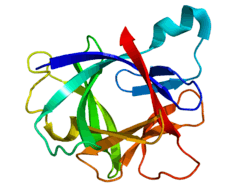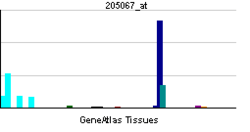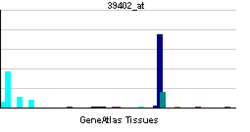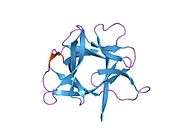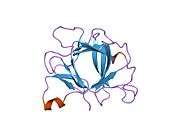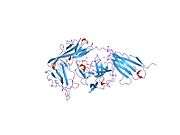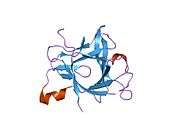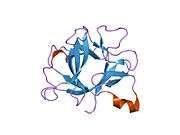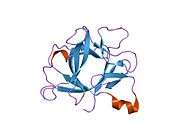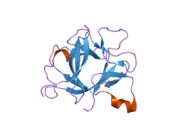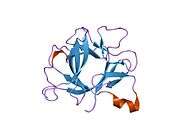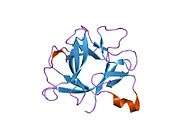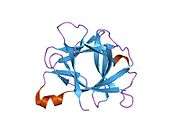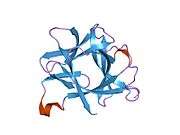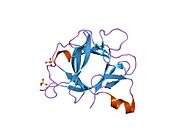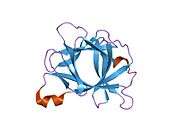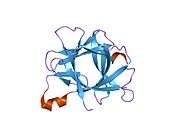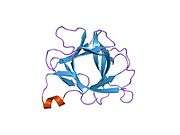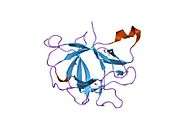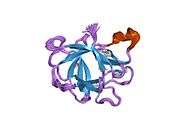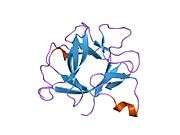Interleukin 1 beta
| View/Edit Human | View/Edit Mouse |
Interleukin 1 beta (IL1β) also known as '"leukocytic pyrogen"', "'leukocytic endogenous mediator'", "'mononuclear cell factor'", "'lymphocyte activating factor'" and other names, is a cytokine protein that in humans is encoded by the IL1B gene.[3][4][5][6] There are two genes for Interleukin-1 (IL-1): IL-1 alpha and IL-1 beta (this gene). IL-1β precursor is cleaved by cytosolic caspase 1 (interleukin 1 beta convertase) to form mature IL-1β.
Function
The fever-producing property of human leukocytic pyrogen (Interleukin 1) was purified by Dinarello in 1977 (PNAS) with a specific activity of 10-20 nanograms/kg. In 1979, Dinarello reported that purified human leukocytic pyrogen was the same molecule that was described by Igal Gery in 1972.[7][8][9] He named it lymphocyte-activating factor (LAF) because it was a lymphocyte mitogen. It was not until 1984 that interleukin 1 was discovered to consist of two distinct proteins, now called interleukin-1 alpha and interleukin-1 beta.[4]
IL-1β is a member of the interleukin 1 family of cytokines. This cytokine is produced by activated macrophages as a proprotein, which is proteolytically processed to its active form by caspase 1 (CASP1/ICE). This cytokine is an important mediator of the inflammatory response, and is involved in a variety of cellular activities, including cell proliferation, differentiation, and apoptosis. The induction of cyclooxygenase-2 (PTGS2/COX2) by this cytokine in the central nervous system (CNS) is found to contribute to inflammatory pain hypersensitivity. This gene and eight other interleukin 1 family genes form a cytokine gene cluster on chromosome 2.[10]
Properties
The molecular weight of the proteolytically processed IL1B is 17.5 kDa. IL1B has the following amino acid sequence:
- APVRSLNCTL RDSQQKSLVM SGPYELKALH LQGQDMEQQV VFSMSFVQGE ESNDKIPVAL GLKEKNLYLS CVLKDDKPTL QLESVDPKNY PKKKMEKRFV FNKIEINNKL EFESAQFPNW YISTSQAENM PVFLGGTKGG QDITDFTMQF VSS
The physiological activity determined from the dose dependent proliferation of murine D10S cells is 2.5 x 108 to 7.1 x 108 units/mg.
Clinical significance
Increased production of IL-1B causes a number of different autoinflammatory syndromes, most notably the monogenic conditions referred to as CAPS, due to mutations in the inflammasome receptor NLRP3 which triggers processing of IL-1B.[11]
Intestinal Dysbiosis has been observed to induce Osteomyelitis through a IL-1β dependent manner.[12]
Therapies targeting interleukin 1 beta
Canakinumab is a human monoclonal antibody targeted at IL-1B, and approved in many countries for treatment of cryopyrin-associated periodic syndromes.
Orthographic note
Because many authors of scientific manuscripts make the minor error of using a homoglyph, sharp s (ß), instead of beta (β), mentions of "IL-1ß" [sic] often become "IL-1ss" [sic] upon automated transcoding (because ß transcodes to ss). This is why so many mentions of the latter appear in web search results.
See also
References
- ↑ "Human PubMed Reference:".
- ↑ "Mouse PubMed Reference:".
- ↑ Auron PE, Webb AC, Rosenwasser LJ, Mucci SF, Rich A, Wolff SM, Dinarello CA (1984). "Nucleotide sequence of human monocyte interleukin 1 precursor cDNA". Proc. Natl. Acad. Sci. U.S.A. 81 (24): 7907–11. doi:10.1073/pnas.81.24.7907. PMC 392262
 . PMID 6083565.
. PMID 6083565. - 1 2 "Catabolin" is the name given by Jeremy Saklatvala for IL-1 alpha. March CJ, Mosley B, Larsen A, Cerretti DP, Braedt G, Price V, Gillis S, Henney CS, Kronheim SR, Grabstein K (1985). "Cloning, sequence and expression of two distinct human interleukin-1 complementary DNAs". Nature. 315 (6021): 641–7. doi:10.1038/315641a0. PMID 2989698.
- ↑ Clark BD, Collins KL, Gandy MS, Webb AC, Auron PE (1986). "Genomic sequence for human prointerleukin 1 beta: possible evolution from a reverse transcribed prointerleukin 1 alpha gene". Nucleic Acids Res. 14 (20): 7897–1914. doi:10.1093/nar/14.20.7897. PMID 3490654.
- ↑ Bensi G, Raugei G, Palla E, Carinci V, Tornese Buonamassa D, Melli M (1987). "Human interleukin-1 beta gene". Gene. 52 (1): 95–101. doi:10.1016/0378-1119(87)90398-2. PMID 2954882.
- ↑ Gery I, Gershon RK, Waksman BH (1972). "Potentiation of the T-lymphocyte response to mitogens. I. The responding cell". J. Exp. Med. 136 (1): 128–142. doi:10.1084/jem.136.1.128. PMC 2139184
 . PMID 5033417.
. PMID 5033417. - ↑ Gery I, Waksman BH (1972). "Potentiation of the T-lymphocyte response to mitogens. II. The cellular source of potentiating mediator(s)". J. Exp. Med. 136 (1): 143–155. doi:10.1084/jem.136.1.143. PMC 2139186
 . PMID 5033418.
. PMID 5033418. - ↑ Gery I, Handschumacher RE (1974). "Potentiation of the T lymphocyte response to mitogens. III. Properties of the mediator(s) from adherent cells". Cell. Immunol. 11 (1-3): 162–9. doi:10.1016/0008-8749(74)90016-1. PMID 4549027.
- ↑ "Entrez Gene: IL1B interleukin 1, beta".
- ↑ Masters SL, Simon A, Aksentijevich I, Kastner DL (2009). "Horror autoinflammaticus: the molecular pathophysiology of autoinflammatory disease (*)". Annu. Rev. Immunol. 27: 621–68. doi:10.1146/annurev.immunol.25.022106.141627. PMC 2996236
 . PMID 19302049.
. PMID 19302049. - ↑ Lukens JR, Gurung P, Vogel P, Johnson GR, Carter RA, McGoldrick DJ, Bandi SR, Calabrese CR, Vande Walle L, Lamkanfi M, Kanneganti TD (December 2014). "Dietary modulation of the microbiome affects autoinflammatory disease". Nature. 516 (7530): 246–9. doi:10.1038/nature13788. PMC 4268032
 . PMID 25274309.
. PMID 25274309.
Further reading
- Smirnova MG, Kiselev SL, Gnuchev NV, Birchall JP, Pearson JP (2003). "Role of the pro-inflammatory cytokines tumor necrosis factor-alpha, interleukin-1 beta, interleukin-6 and interleukin-8 in the pathogenesis of the otitis media with effusion". Eur. Cytokine Netw. 13 (2): 161–72. PMID 12101072.
- Griffin WS, Mrak RE (2002). "Interleukin-1 in the genesis and progression of and risk for development of neuronal degeneration in Alzheimer's disease". J. Leukoc. Biol. 72 (2): 233–8. PMID 12149413.
- Arend WP (2003). "The balance between IL-1 and IL-1Ra in disease". Cytokine Growth Factor Rev. 13 (4-5): 323–40. doi:10.1016/S1359-6101(02)00020-5. PMID 12220547.
- Chakravorty M, Ghosh A, Choudhury A, Santra A, Hembrum J, Roychoudhury S (2004). "Ethnic differences in allele distribution for the IL8 and IL1B genes in populations from eastern India". Hum. Biol. 76 (1): 153–9. doi:10.1353/hub.2004.0016. PMID 15222686.
- Joseph AM, Kumar M, Mitra D (2005). "Nef: "necessary and enforcing factor" in HIV infection". Curr. HIV Res. 3 (1): 87–94. doi:10.2174/1570162052773013. PMID 15638726.
- Maruyama Y, Stenvinkel P, Lindholm B (2005). "Role of interleukin-1beta in the development of malnutrition in chronic renal failure patients". Blood Purif. 23 (4): 275–81. doi:10.1159/000086012. PMID 15925866.
- Roy D, Sarkar S, Felty Q (2006). "Levels of IL-1 beta control stimulatory/inhibitory growth of cancer cells". Front. Biosci. 11: 889–98. doi:10.2741/1845. PMID 16146780.
- Copeland KF (2005). "Modulation of HIV-1 transcription by cytokines and chemokines". Mini Rev Med Chem. 5 (12): 1093–101. doi:10.2174/138955705774933383. PMID 16375755.
- Prinz C, Schwendy S, Voland P (2006). "H pylori and gastric cancer: shifting the global burden". World J. Gastroenterol. 12 (34): 5458–64. PMID 17006981.
- Kamangar F, Cheng C, Abnet CC, Rabkin CS (2006). "Interleukin-1B polymorphisms and gastric cancer risk--a meta-analysis". Cancer Epidemiol. Biomarkers Prev. 15 (10): 1920–8. doi:10.1158/1055-9965.EPI-06-0267. PMID 17035400.
External links
- IL1B protein, human at the US National Library of Medicine Medical Subject Headings (MeSH)
This article incorporates text from the United States National Library of Medicine, which is in the public domain.
